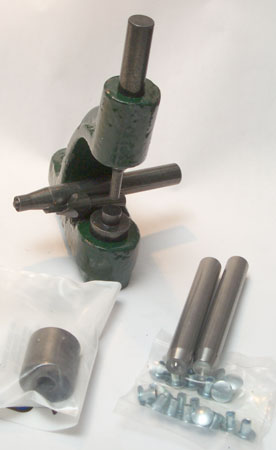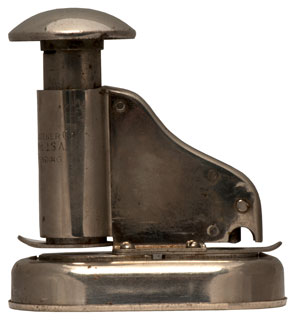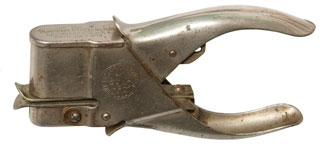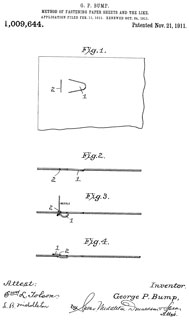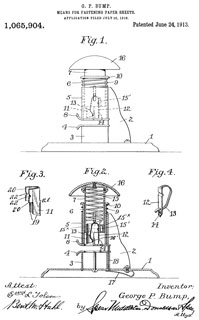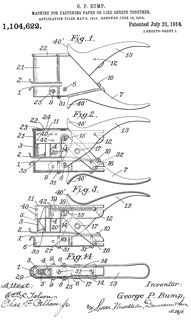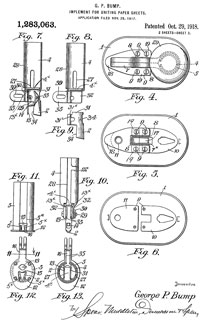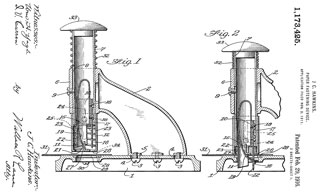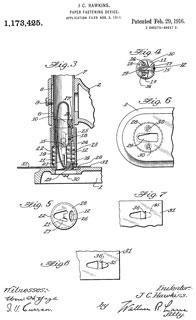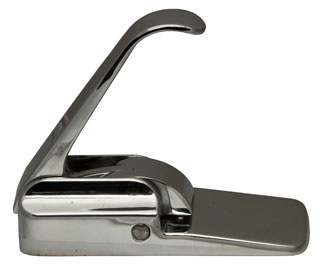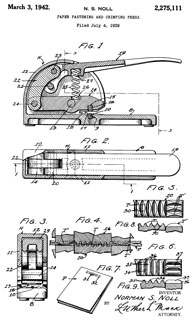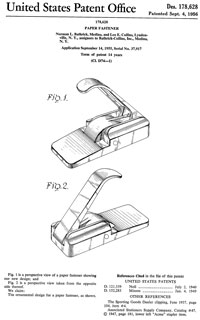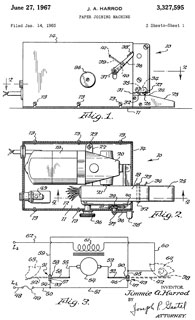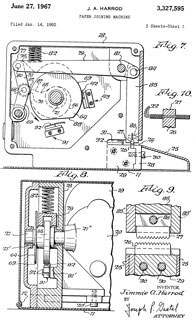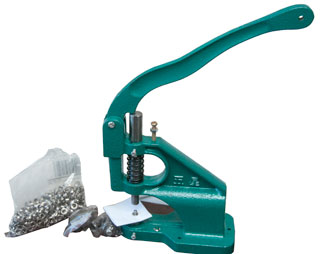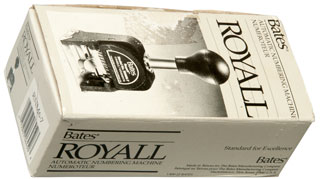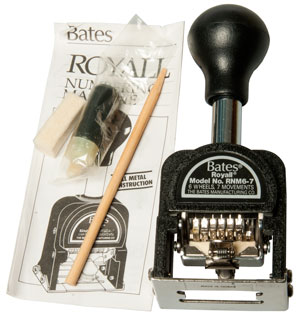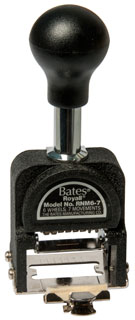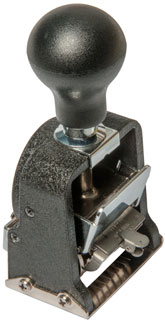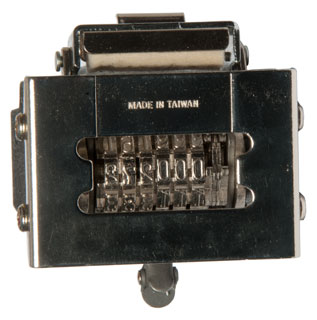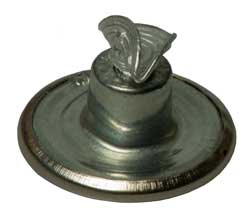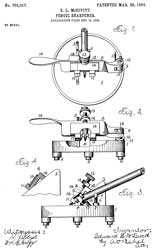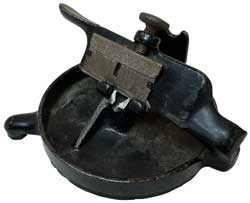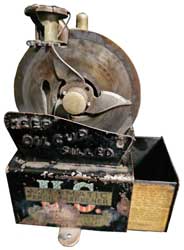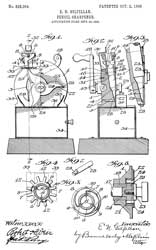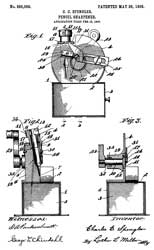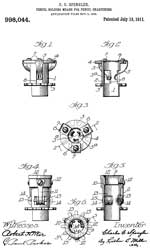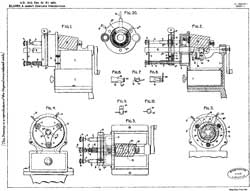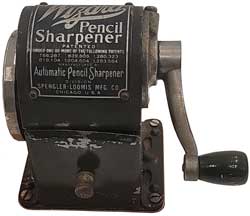The eyelet is very similar to a
rivet except the eyelet has a hole all the way through.
Eyelets are typically made of brass. Eyelets are much easier
to set than rivets. My first exposure to them was making
double sided printed circuit boards at a time prior to vias so
eyelets were installed to make an electrical connection between
the top and bottom layers. They were installed by a
pneumatic powered machine that had auto feed and a foot pedal to
activate the setting operation. The machine came from a shoe
manufacturing operation.
A Grommet is similar but is used with a washer, typically in
fabric. For example the corners of a tarp may have grommets
to allow using ropes to hold it.
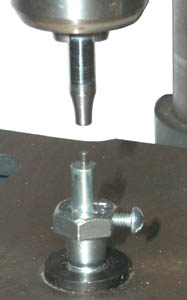
This is tooling
that allows using the press function of a
Drill Press (not the drill motor) to
set eyelets.
The top tool has a central cone to flare out the eyelet's open end
and then a radiused part to form the reverse bend.
The bottom tool holder has 3/8-16 threads that match the
T-slot fittings for this bench top
drill press and so an Enco flanged nut (
407-5024)
with it's points ground very slightly makes a good centered fit
into the top drill press table center hole. All that's
required to line up the top and bottom tools is to rotate the
table left or right a little and then clamp it.
The bottom tool holder appears to have been made from a bolt that
has two concentric holes drilled on the long axis. The upper
hole is about 1/4" diameter and holds the bottom anvil. The
retractable pin sticking up in the center fits inside the shank of
the eyelet, but it too big to clear the small lip at the end of
the eyelet thus it will lift up an eyelet that's shorter than it's
height above the anvil. The lower hole clears the coil
spring. That a very handy thing helping to insert the eyelet
into the work piece. Below the retractable pin is a spring
pushing it up.
If you try to form an eyelet without a pin inside the eyelet body,
the body will crumple instead of holding it's shape. Another
way to get the needed internal support is to make the top tool
with a fixed pin that will go into the hole in the anvil.
Eyelets are available in
many diameters and
lengths. The nominal diameter of the hole is how the
diameter is specified and the ones I'm using are 3/32, 1/8 and
5/32". The 3/32" tooling is shown in the photo.
In order for the top tool to fit inside the snaps used for 9 Volt
batteries the diameter has been reduced from what a stock top tool
looks like. This was done with the tool in the drill press
with the motor running using a hand held grinding stone.
The top tool is installed in the chuck with it's top end seated on
the inside of the chuck so when downward pressure is applied the
tool will not slip in the chuck jaws. It takes some force to
seat an eyelet, but not by any means excessive.
Offset Eyelet Drill Press setup
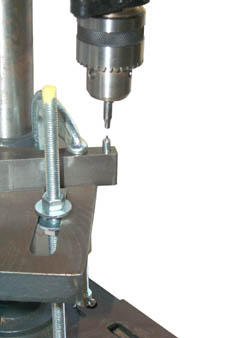
In the above photo the bottom tool is located in the center hole
of the movable table. In the photo at the left the bottom
tool (including the pin and spring) are located in a custom offset
holder made from 1" x 1/2" iron bar. in the end of the bar
there's a 6-32 tapped hole for a pinch screw. That stock
round head screw does not work because it does not let the center
of the bottom tool get to the center position of a AA battery in
the battery holder.
The movable drill press table can be tilted left to right and when
pressure is applied to seat an eyelet the table tips to the right
no matter how tight the locking nut is tightened. The fix
for that is to install a one foot long 3/8-16 all thread rod, four
nuts and four washers to lock the distance between the drill press
base and the table.
Siska Manual Tooling
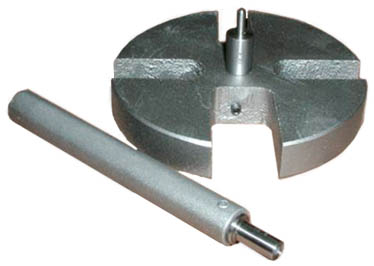
The Siska tooling uses a system that does not need a receding
center pin. Their bottom tool does the eyelet forming unlike
the Keystone tooling where the top die does the forming. The
Siska top tool has a center clearance hole and the bottom die has
a fixed pin.
The top and bottom
dies
fit a 3/8" diameter hole in either this manual tool holder set or
into the arbor press or more automated machines.
The shank diameter is very important since it needs to clear
whatever is near the eyelet.
A locating point is shown on a bottom tool that makes a scored
setting. I prefer the roll setting where the lower die would
have a half doughnut around the center pin.
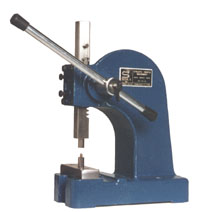
The
next step up from hand tooling is an
arbor press.
They come in 1/2, 1 and 2 ton capacities.
The key advantage I see is that the alignment between the top and
bottom tools is much better.
When using a lower die with a cutting point (just a square top
with sharp corners), it's important that the top and bottom dies
are well aligned.
The two adjusting screws on the front would allow minimizing front
to back slop in the ram. Don't know about side to side slop.
Stimpson 405 Press
I debated getting an arbor press, the Stimpson 405 press or
tooling for using a hammer. The fancier auto feed presses
are what I used long ago to install shoe eyelets into printed
circuit boards to make vias (after soldering each on both
sides), but those presses are too expensive for me. So got
the 405 press with compound linkage and some customized tooling
as well as some of the stock eyelet tooling.
The arbor press is a simple rack and pinion machine where the
mechanical advantage is the operating arm length (minus a
little) divided by the pinion gear radius. This works out
to around 10 and the ratio is the same for all positions of the
arm.
The Stimpson 405 has a three bar linkage and it's mechanical
advantage changes with arm position. It approaches
infinity at bottom dead center. I estimate it at 100 but
it's very dependent on how close to going over center the
tooling allows. Needless to say this makes a huge
difference in ease of use and it's something I didn't know until
I had the press. It would be better to have an adjustable
lower tool so that you could optimize the leverage to match the
thickness of the work.
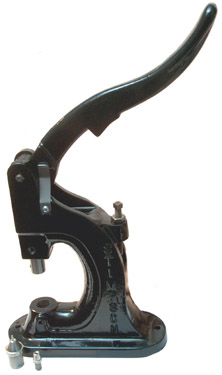
|

|

|
Stimpson 405 Press
|
GS-5 Stock tooling
|
Compound linkage
|
This is the current version (22 Apr 2008) 405 made from an
aluminum casting. It's impressive to look at with a mirror
like black finish, i.e. anything in the photos that looks like a
blemish is a reflection. The action is smooth and feels
precise, but the proof is in the pudding.
The top and bottom tools use different mating diameters. The
bottom tool is 13/16" and the top too is 3/8". Keystone and
Siska use 3/8" for both tools thus allowing you to install them
either way. Stimpson seems to want you to only install them
one way. The bottom tool requires a 3/16" hex wrench
and the top tool a 1/8" hex wrench. Both tools have flats
for the setscrews and a close fit to the tool.
If you are left handed then the press should be mounted as shown
in the photo at left above. That way you work the press with
your off hand while your precision hand is used to work with the
eyelets. If mounted with the handle facing back you would
need long arms to work it.
In addition to the eyelet tools the 405 also can be used with
Grommet tools and also round sheet metal punches in the size range
of 3/32 to 3/4" diameters.
Custom Tooling
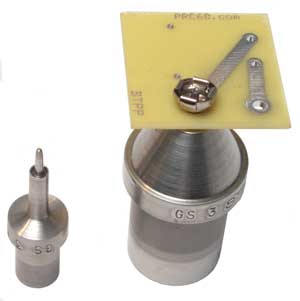
This is a custom tool made to install 9 Volt
battery snaps. The post in the center of the snap is spring
loaded and gets pressed down by the top tool which is shown to the
left upside down. The spring loaded post holds an eyelet,
the PCB and keeps the snap in place until the top tool sets the
eyelet. This is upside down from the stock tooling shown
above but is the correct way to manually do eyelets.
GS Numbers
The GS (Graduated Size) system is based on 1/32" So a GS-5
tool is for use on eyelets that go into a 5/32" (0.156") hole.
GS eyelets are numbered
GS
[hole dia in 32
nds of a inch]
-[Length under flange in 32
nds of a
inch]
The smallest GS series that's mentioned in the Stimson catalog is
GS 2-2 (1/16 dia hole x 1/16 long under flange) and the largest GS
7-14 ( 7/16 dia hole x 7/8" long under flange).
I suspect there's some logical way the flange diameter is
determined but have not tried to analyze it yet.
The Keystone two digit eyelet numbers are the GS numbers.
Tooling
It turns out the stock tooling would work for installing an eyelet
into something thin and flat, but not into real world
applications. Custom tooling is needed.
Caution
A very close tolerance fit is used between the tools and the
press. If an operator that's not mechanically inclined
changes the tools and does not seat the set screw on the tool's
flat, then the precision surface of the tool gets distorted thus
locking the tool into the press. There are a couple of
notches in the tools that allow a wedge to be driven between
the press and tool to get it out. Then the tool needs to be
cleaned up.
Problem
There is a finger shaped metal strap that presses against the
hand lever so that when the lever is up it will stay
there. The problem is the metal of the strap (steel) is
very similar to the metal of the hand lever (cast iron) and so
there is galling. Along with the galling, and the main
reason for the "fix" is the very loud noise that's much worse
than fingernails on a blackboard.
The fix from idea to working took about 10 minutes. Just cut
a strip of
Phosphor Bronze sheet
metal a little wider than the finger, drill a hole for the
mounting screw and put it between the two.
Later an upside down "U" was added to the Phosphor Bronze to keep
it from getting pulled down.

You can buy the Phosphor Bronze from me at:
http://www.prc68.com/P/Prod.html#PBBK
Eyelet Patents
372826 Eyelet-setting
machine, Edwin
B. Stimpson, Nov 8, 1887, 227/60;
221/167; 221/241 - auto eyelet feed, bench top machine
391208
Machine for Setting Eyelets, Edwin
B. Stimpson, Oct 16, 1888, - auto
eyelet feed, bench top machine
736163
Eyeleting-machine, Edwin
B. Stimpson, 1903-08-1, 221/182; 221/188 - foot operated from standing
position, free standing machine
863330
Headless rivet, Edwin
B. Stimpson,1907-08-13, 411/457; 256/54 -
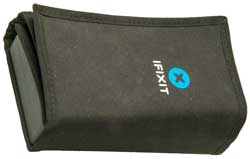
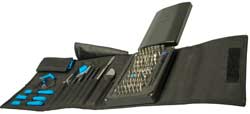
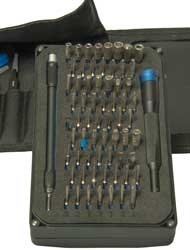
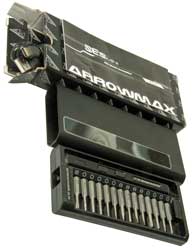
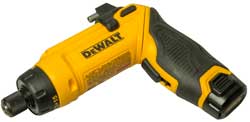
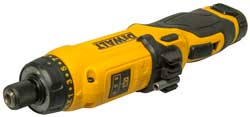
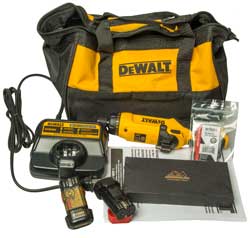








 This is a custom tool made to install 9 Volt
battery snaps. The post in the center of the snap is spring
loaded and gets pressed down by the top tool which is shown to the
left upside down. The spring loaded post holds an eyelet,
the PCB and keeps the snap in place until the top tool sets the
eyelet. This is upside down from the stock tooling shown
above but is the correct way to manually do eyelets.
This is a custom tool made to install 9 Volt
battery snaps. The post in the center of the snap is spring
loaded and gets pressed down by the top tool which is shown to the
left upside down. The spring loaded post holds an eyelet,
the PCB and keeps the snap in place until the top tool sets the
eyelet. This is upside down from the stock tooling shown
above but is the correct way to manually do eyelets.
